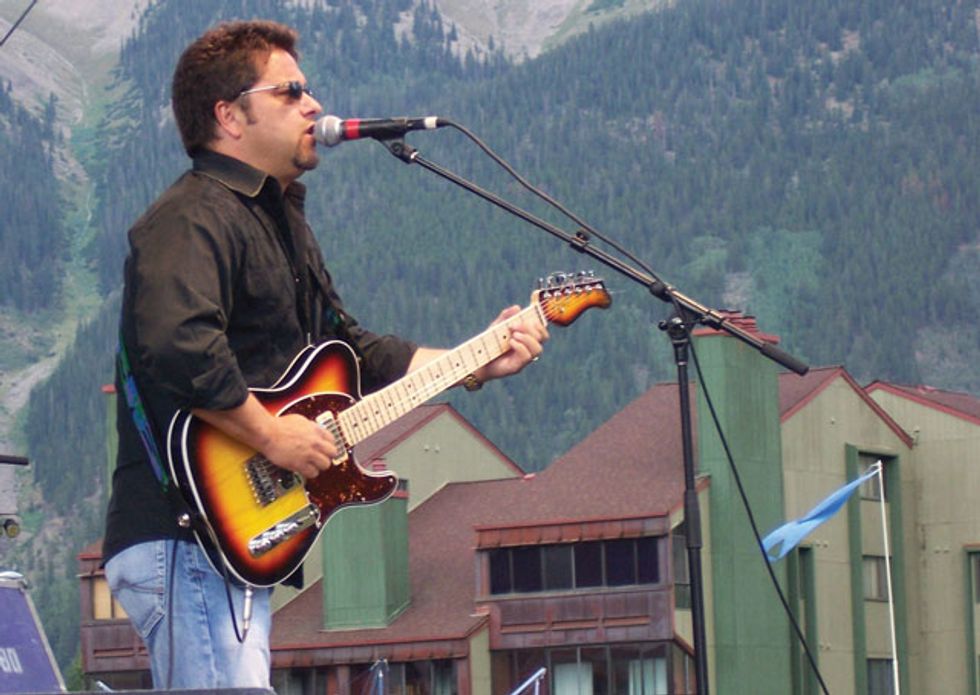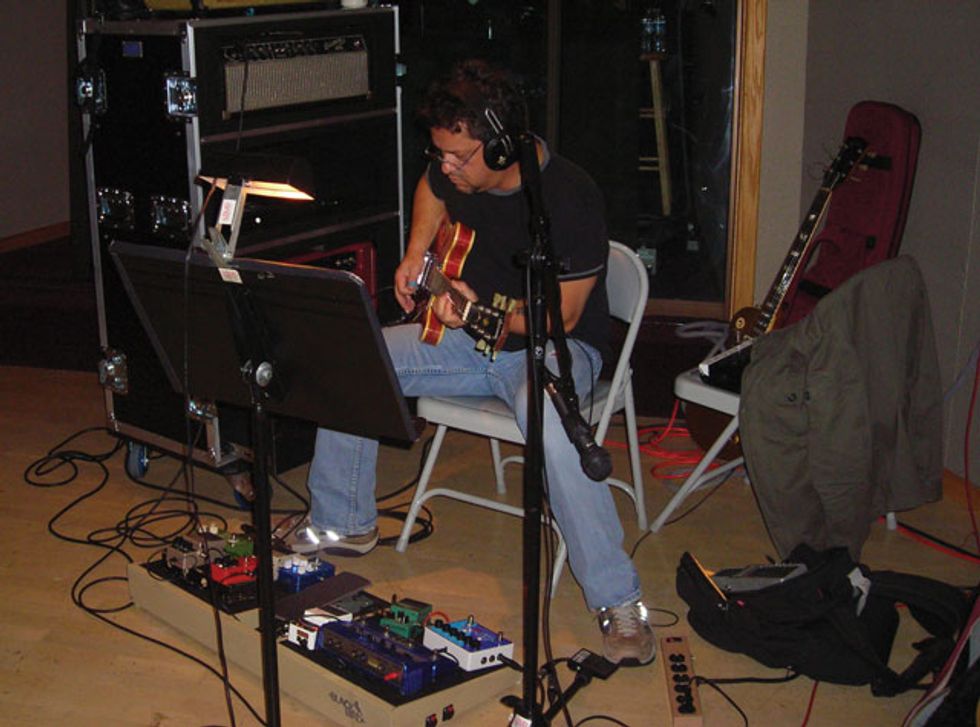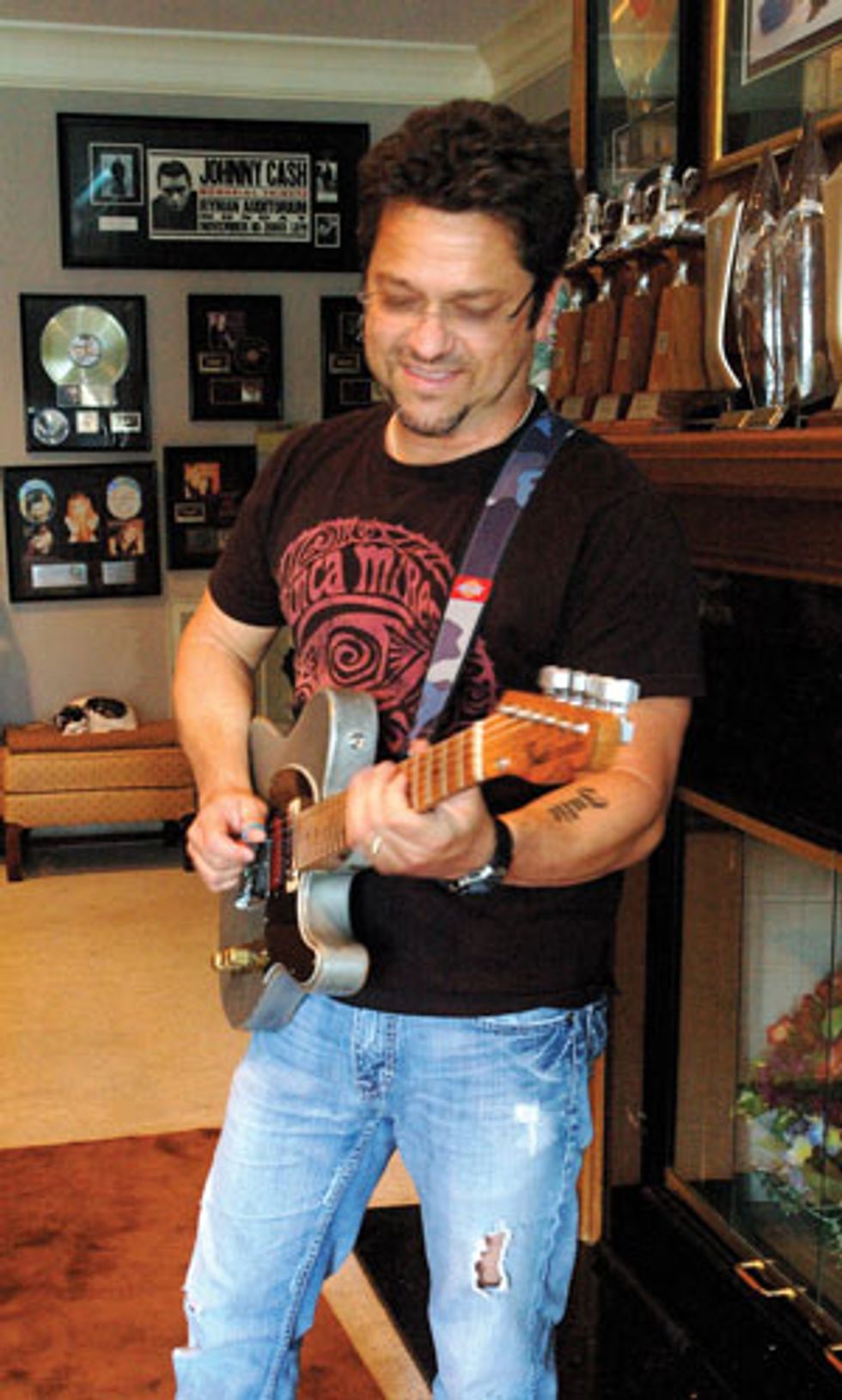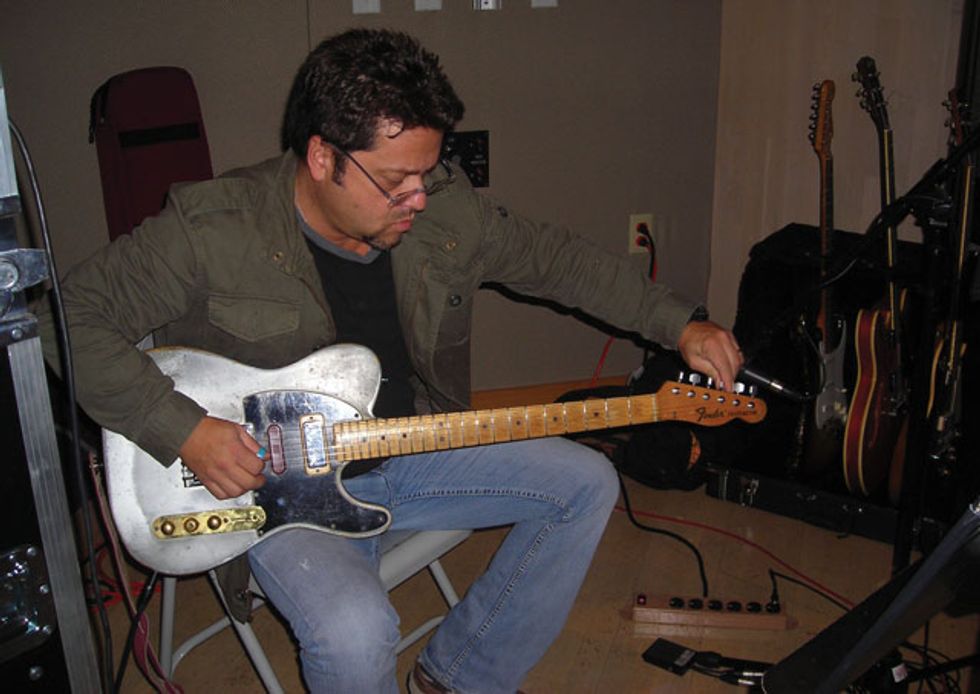After accidentally riveting a hole completely through his thumb while working at a toolbox factory, Brent Mason realized that if he didn’t follow his dream of becoming a professional guitarist, sooner or later that dream wouldn’t be an option. So the native of Van Wert, Ohio, hit the road at age 21 and headed straight for Nashville. Not long after arriving in “Music City,” Mason became a fixture on the studio scene. He eventually became the No. 1 session player in town and one of the most-recorded guitarists in history. Along the way, he’s won countless awards, including a Grammy for Best Country Instrumental Performance (with Brad Paisley, Albert Lee, and John Jorgenson, among others), CMA Musician of the Year (twice), and the Academy of Country Music Guitarist of the Year—which he’s pulled off an astonishing 12 times. In addition to being a consummate hired gun, Mason is also a highly regarded virtuoso solo artist.
The road to becoming the “Nashville Session King” began in the late ’80s, when Mason scored a gig as a songwriter for CBS Songs. He co-wrote numerous songs and played all of their guitar parts. When the songs were later pitched to artists and producers, the question out of their mouths was always, “Who’s playing guitar on that?” And when many of them found out it was Mason, they’d seek him out for their recordings. Higher-profile artists like Keith Whitley also took notice—Mason played and co-wrote tracks such as “Heartbreak Highway” from I Wonder Do You Think of Me, Whitley’s final album before his tragic passing. Soon, Mason became first-call on just about every A-list session, including those for albums by Reba McEntire, Shania Twain, Rascal Flatts, Toby Keith, and Neil Diamond. He also did soundtrack work for TV shows like Friends and movies like A Few Good Men.
The session ace’s new DVD, Brent Mason: Recording Guitar [musicPROmedia], offers a behind-the-scenes look at the inner workings of a typical tracking session. The nearly two-hour video is a must-see for any guitarist interested in learning about the creative process of putting together guitar parts at a professional level. Even if you have no interest in session work, the video offers useful tips and insights about creating complementary guitar parts and choosing the right gear for the job. A good portion of the DVD documents Mason’s process of layering guitar tracks (it even includes PDFs of notated transcriptions), including his rationale for when to use different instruments, and how to punch in tricky parts. At the end, you get to hear the fully arranged finished product. Shred fans will also delight in seeing Mason record four improvised passes of a hellacious solo, with a great moment in the third pass when Mason adds more drive to his tone but then stops cold during the outro solo, shakes his head, and says, “The overdrive doesn’t work on this.”
We recently caught up with Mason to talk about how the studio scene has changed over the years, and to get advice on dealing with the creative and business aspects of being a working guitarist. Oh, and of course we talked chops and gear, too.
What makes a great session
player?
The idea is to walk out of there
with people going, “Wow, he
must play that every day. He lives
and breathes that.” If you sit me
in a studio, I’ll make sure that
by the time I’m out of there it
sounds like I’ve been playing that
music every night. I can go from
a jazz session one day to playing
hillbilly twang on an Alan
Jackson session the next. There
are lots of Nashville guys like
that, who can really play. Even
though everybody correlates my
style with a certain type of country
or country rock, I like and
play jazz and all kinds of music.
Are there any cons to being a
session cat?
The only negative thing about
the studio scene—and I don’t
really want to call it negative—
is that you kind of lose who
you are, because you become
such a chameleon. And you
become such a perfectionist
that, after a while, you might
not like anything anymore. Like
when somebody wants to send
you some music and you start
thinking, “Well, I know it’s not
going to be good, but go ahead
and send it.”
 Mason at an outdoor festival with one of his Valley Arts signature guitars,
which features a Gibson mini-humbucker in the neck position, a Duncan Hot
Stack in the middle, and a Duncan Vintage Lead Stack in the back position.
Mason at an outdoor festival with one of his Valley Arts signature guitars,
which features a Gibson mini-humbucker in the neck position, a Duncan Hot
Stack in the middle, and a Duncan Vintage Lead Stack in the back position.People are recording at home
now more than ever. With the
ease of cutting and pasting,
even non-musicians today are
putting out tracks from pasted
loops. How has that affected
the studio scene?
I could never imagine someone
like Ray Charles or the Beatles
doing that. If we did that on
everything, it would become
boring and stagnant after a
while. I think that’s the charm
of recording, to have a realistic
approach and spontaneity.
There’s still a lot of the human element left here in Nashville, with people recording tracks together, which is my favorite way of cutting tracks—having everybody in front of each other, all in one room for one session to get the right vibe going.
Do you have to play all the way
through a whole track anymore?
I play through the whole track.
That’s the ideal thing. There
will be some overdubbing after
that. I know I’ve done some
things where everything was
pieced together and sent over
the internet. But you can copy
[and loop] some things without
it being too noticeable—like a
pop or disco-type song, where
it’s just constant repetition.
You’re actually making yourself
available for session work
over the internet now, right?
Yeah. I can see that it’s kind of the
wave of the future. It’s inevitable.
Ironically, most of that isn’t from
Nashville. It’s from all around the
world—England, Ireland, Cuba
[laughs]. [The clients] send specific
information on what they’re
looking for. Like, they might ask
for a twangy baritone part for one
section and a Buck Owens-type
part for another section, or ask for
a more rockin’ ZZ Top vibe. We’ll
discuss everything before I start to
record, and I’ve never really had
any discrepancies.
Do you prefer working alone
to a studio session?
There are good parts and bad
parts about it. You don’t see other
players. You sit around in your
pajamas and do your parts, and
then you get cabin fever after a
while. The plus is that you can
really zero in on some great guitar
tones, and you can do the ultimate
solo. In Nashville, we record
so much that you might only get
like 15 minutes to record a solo.
 Mason in the studio with his ’76 ES-335 and a red Matchless DC30 barely visible behind
the music stand.
Mason in the studio with his ’76 ES-335 and a red Matchless DC30 barely visible behind
the music stand.But does taking away that
time limit ever lead to obsessing
over minute details that
may not be that important
rather than just sending out
a perfectly good track?
I don’t overthink it. I’ve been
doing this for years. I can get a
good solo and it wouldn’t take all
day. I’ll do a couple of solos and
they can pick out the one they
want. You just play what you hear,
and if it’s soulful and it moves
you, it’ll probably move them.
Because there’s no immediate
feedback, what happens
if parts come out differently
than the client expects?
It’s no big deal. If they say, “Can
you redo this?” I’ll just call it up
and knock it out. But if they
wait too long, it might be a laborious
thing—because you have
to go back through [the digital
files], find it, and get the sounds
again. It’s more about when
you’re all set up and ready with
the tones, because when you go
on to something else, your mind
goes to something else.
Another option is you can always Skype or iChat somebody while you’re doing something. You just have to know if they’re going to be pleasant to work with. You can always shut them off if they’re assholes.
Opening the doors to sessions
for anyone online could
introduce a different dynamic—
like, say, getting hired by
someone who wants his daughter
to be the next Rebecca
Black but who also perhaps
has unrealistic expectations in
comparison to an industry pro.
How do you set your limits?
You leave a little grace period
before you shut it down. I usually
get paid in full first through
PayPal or direct bank accounts.
That’s how I weed it out, to be
honest with you. Some people
are, like, “I’ll give you a deposit of
half and then the other half when
it’s done.” When I tell them I
need to be paid in full, if they’re,
like, “I don’t want to do that,”
then I’m, like, “Nah,” and I move
on. But I haven’t had any trouble.
How important is it for a
session player to be able to
sight read?
It’s always good to be able to
read to a certain extent. We’ve
got this number system that we
use in Nashville [the Nashville
number system], and the only
kind of notation that might be
on a chart is like signature licks,
hook licks, or a written-out
intro. Or, if a bar has syncopated
stops, all of the syncopated 16thor
eighth-notes might be written
out. But that’s about it, nothing’s
written out from top to bottom.
 Mason uses a thumbpick so much that he used to call it his “pacifier.”
Mason uses a thumbpick so much that he used to call it his “pacifier.”Nashville’s probably got less reading than anywhere else, because we’re so big on the creative aspect of developing a song. We generally don’t hear the song or get charts or mp3s until we go into the studio to work on the record—that’s the first time we’ll hear what we’re doing. But on a big record, you’ll have, like, three hours to do one or two songs.
Would an L.A. guy who’s
used to reading fully notated
scores have a hard time acclimating
to the Nashville scene
and vice versa?
It could be if somebody just got
thrust into it for the first time,
because it moves fast here. But
we’ve had some L.A. transplants
that just blended in nicely and
brought some of their L.A. into
Nashville. And if we go there,
we might sweat blood while trying
to read a symphonic chart.
I’d have to really decipher it. You
might have to say, “I have to go
to the bathroom for a minute,”
and take the chart to the bathroom
and study it. I admire guys
like Tommy Tedesco, who could
flip their charts and read it backwards
[laughs].
One of the trickiest aspects
for young, non-union musicians
trying to break into the
scene is dealing with money.
Because it can be a fairly
secretive and sensitive topic,
a newcomer might not know
what the average rates are and
either ask for too much—and
disqualify themselves—or too
little, which shortchanges them
and lowers the market rate for
peers. What advice do you have
for negotiating rates?
You have to have some kind of
template for that. Here, with
the union, we have several different
scales that depend on the
project you’re doing. There’s the
demo scale—where publishing
companies demo songs to
pitch—and there’s a set scale
for that. That’s the lowest. Then
you might have some dude
from Iowa, and he’s cutting a
record to sell out of the back of
his truck. That’s what we call
“limited pressing,” when they’re
going to press only a couple
thousand of them—less than
10,000. Above limited pressing
is the “low-budget master” for
established but not big record
labels, like independent labels
with less inventory. Then you
jump up from that to “master”
scale, where you’re into the big
record labels like Warner Bros.,
Sony, or Atlantic.
I advise everybody to join a union, because you get a pension that way. A lot of young guys don’t think about that. They’re just glad to be playing, because it’s a fun life of rock ’n’ roll. But when you get to be about 50 you think, “Gosh, I wish I had a retirement plan.” But even if you’re not in a union, you can use the union scale as a template.
You’re known for your flexibility
and adaptability, but also
for your tremendous chops.
How did you develop your
technique to such a high level?
It was about deciphering guys
like Pat Martino by ear from a
phonograph record until you dug
a hole into the vinyl. Now we
can slow all this stuff down with
software. I never went to college
for music. But speed is just
practice and the will to make
it happen. It’s like, “George
Benson’s burning this down—
I’ve got to do it, too.” Where
there’s a will, there’s a way.
 Mason tunes his Joe Glaser-modified ‘68 Fender Tele, which features a middle pickup with its own volume knob.
Mason tunes his Joe Glaser-modified ‘68 Fender Tele, which features a middle pickup with its own volume knob.
Ironically, most sessions do
not call for virtuosic playing.
Yeah, the studio scene is not
about flashiness.
Do you always play with a
thumpick?
Yeah, the thumbpick is my
thing. With a thumbpick, I
can do single-note lines and
you’d think it was a pick. I
use a flat pick sometimes, like
when I’m playing rhythm or
something that would require
an even stroke. Sometimes I’ll
go out to sit in [at a session] and
then be, like, “Arg! I forgot my
thumbpick—let me use your
[standard] pick,” and I have fun
with it. In the past, it used to be
like a pacifier—if I didn’t have
that thumbpick, I couldn’t get
up. I would sneak out with my
head under my coat [laughs].
Do you use your other fingers
in conjunction with the
thumbpick?
Yeah, it’s a hybrid of thumbpick,
middle finger, and ring finger,
especially for arpeggios. And if
it’s something chromatic, I might
just use the thumbpick as a pick.
The first part of Recording
Guitar shows you adjusting
your guitar’s volume knob
a few times, mid-track, during
section changes. Do you worry
about bringing it back to the
same volume when that section
repeats, and if so, how do
you make sure it’s precise?
It doesn’t have to be that
micromanaged! I’ve got a good
sense of where the set volume
should be. If you’re doing a
solo and the level goes down a
little bit, you’re going to hear it
from the engineer: “Man, your
level went down. Bring it up 5
dB or something,” or, “Man,
your track’s not even close to
the volume on that first track.”
You’ll be called out on it if it
fluctuates that much. But it
doesn’t have to be that mathematical.
Your sense of where
it was or where it should be is
usually good enough.
Tell us about the mods you’ve
had done to your ’68 Telecaster—
which has been heard
on thousands of recordings.
Joe Glaser added a middle
pickup that’s wired in with its
own volume knob, which can
be bled in as an out-of-phase
sound. That was all done way
early on, when I was playing in
honky-tonk clubs. I took out
the original pickups because
they were noisy and put a
mini-humbucker in the neck,
and Seymour Duncan Vintage
Stacks for the middle and back.
I love Seymour’s work. [At the
time] I couldn’t afford to have
a Strat, a Les Paul, and a Tele.
I was broke and couldn’t afford
more than one guitar—now
I’ve got about 50.
What about your new Wampler
Hot Wired Brent Mason
Overdrive/Distortion pedal?
It’s got characteristics of a Pro
Co Rat and an Ibanez Tube
Screamer, plus a little bit of a
plexi Marshall thing, too. It’s
also got a fat switch that we
really worked on. If you’re using
an open-back cabinet, sometimes
you’re missing that lowend
push. With this fat switch,
if you hit a low barre chord it
will push at you real big but
still have that open-back sound.
You get that air around it still.
You have a sweet collection of
vintage amps. Could a digital
modeler replace your rig?
No, I don’t think so. Things
like the Eleven Rack are close—
that’s as close as you’re going
to get right now—but I’ve got
to have the real thing. I love
hearing how the amp is going
to sound in a different place.
You might take the amp to a
studio with different acoustics
and it’s going to sound totally
different. To me, that can never
be duplicated or emulated. It’s
so three-dimensional. It’s pretty
remarkable what they can do
these days, and maybe it’s just
me being old-fashioned, but I
love the real thing.
Brent Mason's Gear
Guitars
Modifi ed ’68 Fender Telecaster, ’65 Fender
Stratocaster, ’68 Gibson SG, ’76 Gibson
ES-335, ’73 goldtop Gibson Les Paul,
PRS David Grissom, PRS SE Mike Mushok
Baritone, PRS 12-string acoustic
Amps
’67 Fender Deluxe Reverb, ’65 Fender Twin
Reverb,’65 Fender Bassman, ’63 Fender Bandmaster,
silverface Fender Twin Reverb (modifi
ed to head format), Matchless DC30 driving a
Matchless 2x12 cab, various Little Walter amps
Effects
Wampler Hot Wired Brent Mason Overdrive/
Distortion, Creation Audio Labs MK 4.23
Clean Boost, Voodoo Lab Sparkle Drive, Boss
GE-7 Graphic Equalizer, Analog Man-modded
Boss TR-2 Tremolo, Wampler Ego Compressor,
Electro-Harmonix Stereo Memory Man
with Hazarai, Visual Sound Visual Volume,
Ernie Ball Volume Pedal Jr., Xotic Effects BB
Preamp, Vox wah, Strymon El Capistan, Line
6 DL4 Delay Modeler, Benado multi-effector,
other effects “in piles in a box somewhere”
Strings, Picks, and Accessories
Herco blue thumbpick, Boss TU-2 Tuner,
D’Addario straps, George L’s and Planet
Waves cables
Youtube It
To see Brent mason
chicken-pickin’ up
a storm, check out
the following clips
on YouTube.com.
In this clip from his new Recording Guitar DVD, Mason demonstrates his approach to layering different guitar flavors on a single tune.
The session stud smokes his
way through his signature
tune “Hot Wired.”
Mason sings “Since I Fell For
You,” then takes a burning guitar
solo punctuated by George
Benson-style scat singing.
Bebop meets country on this
2010 video featuring Mason and
his brother Randy.






![Rig Rundown: AFI [2025]](https://www.premierguitar.com/media-library/youtube.jpg?id=62064741&width=1245&height=700&quality=70&coordinates=0%2C0%2C0%2C0)












 Shop Scott's Rig
Shop Scott's Rig













 Zach loves his Sovtek Mig 60 head, which he plays through a cab he built himself at a pipe-organ shop in Denver. Every glue joint is lined with thin leather for maximum air tightness, and it’s stocked with Celestion G12M Greenback speakers.
Zach loves his Sovtek Mig 60 head, which he plays through a cab he built himself at a pipe-organ shop in Denver. Every glue joint is lined with thin leather for maximum air tightness, and it’s stocked with Celestion G12M Greenback speakers.












![Devon Eisenbarger [Katy Perry] Rig Rundown](https://www.premierguitar.com/media-library/youtube.jpg?id=61774583&width=1245&height=700&quality=70&coordinates=0%2C0%2C0%2C0)






